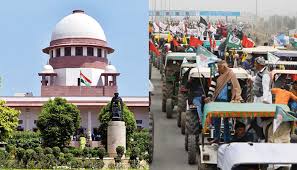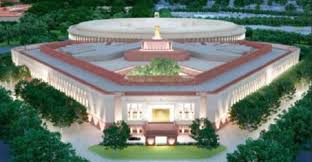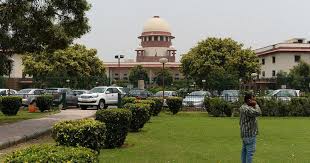Feature
SC to hear PIL for discharge of 70 cured mental patients
 New Delhi:The Supreme Court on Tuesday said that it will hear, after its summer break, a PIL seeking the discharge of 70 patients who are cured of their mental ailments but still lodged with those under treatment at Bareilly Mental and Health Hospital in Uttar Pradesh.
New Delhi:The Supreme Court on Tuesday said that it will hear, after its summer break, a PIL seeking the discharge of 70 patients who are cured of their mental ailments but still lodged with those under treatment at Bareilly Mental and Health Hospital in Uttar Pradesh.
Telling the PIL petitioner, lawyer Gaurav Kumar Bansal, that the matter would be heard on the opening of the court after summer break, a vacation bench of Justice Adarsh Kumar Goel and Justice L.Nageswara Rao asked him why he did not approach the Allahabad High court.
Addressing the query, Bansal said that there were some difficulties in moving the high court as some of the patients who are now cured and have become normal are from other parts of the country including Kerala.
Seeking the release of former patients who have become absolutely normal now, he told the bench that they were living in pathetic conditions with mentally ill patients.
Seeking the discharge of 65 females and five males whose mental health has been restored, the PIL has sought the framing of guidelines for the relief and rehabilitation of the patients who have become normal.
Besides this, the petition has sought direction to three mental hospitals located at Agra, Bareilly and Varanasi to furnish the list of the patients who have been cured of their mental ailments but have not been discharged and are lodged with sick patients.
Giving the account of his meeting with three patients who are totally cured and are normal, Bansal said that all the three wanted to be discharged from the hospital so that they could go back to their places and live in a normal environment.
In his PIL, he said that he visited one of the wards in Bareilly hospital which had two rooms adjacent to each other and in each room, there were around 20 mentally ill patients. He said that what was disturbing was that along with mentally sick patients, the patients who are “absolutely normal and fit to be discharged are also living”.
He said that some of the women patients whose mental health has been restored now are in Bareilly hospital since 1982, 1984 and the 1990s.
Entertainment
Meghalaya Reserves Legalized Gambling and Sports Betting for Tourists

The State Scores Extra High on Gaming-Friendly Industry Index
Meghalaya scored 92.85 out of 100 possible points in a Gaming Industry Index and proved to be India’s most gaming-friendly state following its recent profound legislation changes over the field allowing land-based and online gaming, including games of chance, under a licensing regime.
The index by the UK India Business Council (UKIBC) uses a scale of 0 to 100 to measure the level of legalisation on gambling and betting achieved by a state based on the scores over a set of seven different games – lottery, horse racing, betting on sports, poker, rummy, casino and fantasy sports
Starting from February last year, Meghalaya became the third state in India’s northeast to legalise gambling and betting after Sikkim and Nagaland. After consultations with the UKIBC, the state proceeded with the adoption of the Meghalaya Regulation of Gaming Act, 2021 and the nullification of the Meghalaya Prevention of Gambling Act, 1970. Subsequently in December, the Meghalaya Regulation of Gaming Rules, 2021 were notified and came into force.
All for the Tourists
The move to legalise and license various forms of offline and online betting and gambling in Meghalaya is aimed at boosting tourism and creating jobs, and altogether raising taxation revenues for the northeastern state. At the same time, the opportunities to bet and gamble legally will be reserved only for tourists and visitors.
“We came out with a Gaming Act and subsequently framed the Regulation of Gaming Rules, 2021. The government will accordingly issue licenses to operate games of skill and chance, both online and offline,” said James P. K. Sangma, Meghalaya State Law and Taxation Minister speaking in the capital city of Shillong. “But the legalized gambling and gaming will only be for tourists and not residents of Meghalaya,” he continued.
To be allowed to play, tourists and people visiting the state for work or business purposes will have to prove their non-resident status by presenting appropriate documents, in a process similar to a bank KYC (Know Your Customer) procedure.
Meghalaya Reaches Out to a Vast Market
With 140 millions of people in India estimated to bet regularly on sports, and a total of 370 million desi bettors around prominent sporting events, as per data from one of the latest reports by Esse N Videri, Meghalaya is set to reach out and take a piece of a vast market.
Estimates on the financial value of India’s sports betting market, combined across all types of offline channels and online sports and cricket predictions and betting platforms, speak about amounts between $130 and $150 billion (roughly between ₹9.7 and ₹11.5 lakh crore).
Andhra Pradesh, Telangana and Delhi are shown to deliver the highest number of bettors and Meghalaya can count on substantial tourists flow from their betting circles. The sports betting communities of Karnataka, Maharashtra, Uttar Pradesh and Haryana are also not to be underestimated.
Among the sports, cricket is most popular, registering 68 percent of the total bet count analyzed by Esse N Videri. Football takes second position with 11 percent of the bets, followed by betting on FIFA at 7 percent and on eCricket at 5 percent. The last position in the Top 5 of popular sports for betting in India is taken by tennis with 3 percent of the bet count.
Local Citizens will Still have Their Teer Betting
Meghalaya residents will still be permitted to participate in teer betting over arrow-shooting results. Teer is a traditional method of gambling, somewhat similar to a lottery draw, and held under the rules of the Meghalaya Regulation of the Game of Arrow Shooting and the Sale of Teer Tickets Act, 2018.
Teer includes bettors wagering on the number of arrows that reach the target which is placed about 50 meters away from a team of 20 archers positioned in a semicircle.
The archers shoot volleys of arrows at the target for ten minutes, and players place their bets choosing a number between 0 and 99 trying to guess the last two digits of the number of arrows that successfully pierce the target.
If, for example, the number of hits is 256, anyone who has bet on 56 wins an amount eight times bigger than their wager.





















